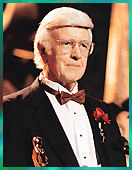|
|
Eben Ostby, Bill Reeves, Sam Leffler and Tom Duff
Development of the Marionette 3-D Computer Animation System.
The creators of Marionette introduced a procedural system for computer animation with an extensible and flexible software architecture that allows creation of high-level controls for the animator. This system was used to create Toy Story, the first three-dimensional com-puter-animated feature film.
Richard Shoup, Alvy Ray Smith and Thomas Porter
Pioneering efforts in the development of digital paint systems used in motion picture production.
Much of the foundation for the numerous contemporary digital paint products for motion pictures can be traced directly back to the early work of these digital pioneers.
Kirk Handley, Ray Meluch, Scott Robinson, Wilson Allen and John Neary
Design, development and implementation of the Dolby CP500 Digital Cinema Processor.
Utilizing digital technology, the CP500 decodes digital soundtracks, facilitates installation, provides unprecedented ease of operation and may also improve analog soundtrack reproduction.
Craig Reynolds
Pioneering contributions to the development of 3-D computer animation for motion picture production.
The early contributions of Mr. Reynolds in the digital animation arena have become both influential and instrumental in the architecture of many later systems developed at companies throughout the computer animation industry.
John Gibson, Rob Krieger, Milan Novacek, Glen Ozymok and Dave Springer
Development of the geometric modeling component of the Alias PowerAnimator system.
The Alias PowerAnimator system is widely regarded in the computer animation field as one of the best commercially available software packages for digital geometric modeling. Used by many motion picture visual effects houses, it has been a benchmark for comparison of modeling tools and has had a major influence on visual effects and animation.
Dominique Boisvert, Rejean Gagne, Daniel Langlois and Richard Laperriere
Development of the "Actor" animation component of the Softimage computer animation system.
The commercially available Softimage 3-D system is widely used in computer animation of three-dimensional characters for the film industry. The "Actor" component provided breakthroughs in animation control and efficiency that led to the widespread use of the Softimage program in visual effects and animation production.
Bill Kovacs for his creative leadership and principal engineering efforts by Roy Hall
Leading to the Wavefront Advanced Visualizer computer graphics system.
The Wavefront System was the first commercial software package for modeling, animating and rendering computer-generated elements and scenes that was adopted into widespread use to create digital images with sufficient quality for theatrical motion pictures.
Joel Johnson of the O'Connor Laboratories
Unique design improvement in the fluid-head counterbalancing techniques used in their Model 2575.
The 2575 is the first spring counterbalanced fluid head to enable the camera to be tilted through a full 180-degree arc. The unique pan-and-tilt head balances the camera package at all tilt angles throughout the full range, allowing the camera to remain where it is positioned without springing back towards the center.
Al Jensen, Chuck Headley, Jean Messner and Hazem Nabulsi of CEI Technology
Production of a self-contained, flicker-free, Color Video-Assist Camera.
This device can be used with virtually any professional motion picture camera and provides flicker-free color or black-and-white video assist images. Switchable options allow for image manipulation and increased low-light sensitivity.
Gunnar P. Michelson
Engineering and development of an improved, electronic, high-speed, precision light valve for use in motion picture printing machines.
The Michelson light valve is capable of making accurate changes in printing beam intensities more rapidly than devices formerly available to the motion picture industry. Mechanical linkages have been eliminated entirely. The all-electronic design makes it possible to preset the vane openings for each of the 50 positions in its total range. As a result, all Michelson light valves in a laboratory can be adjusted to conform to a standard light scale.
For more information on the Sci-Tech Awards, contact the Academy of Motion Picture Arts and Sciences by phone at (310) 247-3090, or by fax at (310) 271-3395, or log onto their web site at www.ampas.org.
